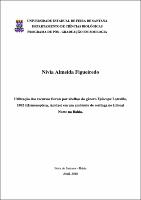| Compartilhamento |


|
Use este identificador para citar ou linkar para este item:
http://tede2.uefs.br:8080/handle/tede/1027Registro completo de metadados
| Campo DC | Valor | Idioma |
|---|---|---|
| dc.creator | Figueiredo, Nívia Almeida | - |
| dc.creator.Lattes | http://lattes.cnpq.br/0166317617858807 | por |
| dc.contributor.advisor1 | Gimenes, Miriam | - |
| dc.date.accessioned | 2020-04-04T19:01:01Z | - |
| dc.date.issued | 2010-03-16 | - |
| dc.identifier.citation | FIGUEIREDO, Nívia Almeida. Utilização dos recursos florais por abelhas do gênero Xylocopa Latreille, 1802 (Hymenoptera, Apidae) em um ambiente de restinga no Litoral Norte na Bahia. 2010. 50 f. Dissertação (Mestrado em Zoologia)- Universidade Estadual de Feira de Santana, Feira de Santana, 2010. | por |
| dc.identifier.uri | http://tede2.uefs.br:8080/handle/tede/1027 | - |
| dc.description.resumo | Abelhas de grande porte, como as espécies do gênero Xylocopa, estão geralmente associadas com a polinização das plantas em ambientes de dunas e restingas que com freqüência, apresentam vegetação herbácea arbustiva, adaptada às condições de alta salinidade e elevada irradiação solar. Este trabalho visa investigar as interações entre as abelhas do gênero Xylocopa e as plantas visitadas para a coleta dos recursos florais, com enfoque nos aspectos morfológicos e temporais. O trabalho de campo foi desenvolvido em Baixio, Esplanada, BA (12º06’31,7’’ S e 37º41’59,8’’ W) (APA do Litoral Norte), mensalmente, de abril/08 a março/09, durante dois dias consecutivos, das 6:30 às 17:00 h. As abelhas foram coletadas durante 5 a 10 min. a intervalos de 1 hora em cada planta florida. Foram coletados 366 indivíduos de Xylocopa spp. representados por: X. cearensis, X. frontalis, X. subcyanea e X. suspecta. Xylocopa cearensis apresentou maior número de indivíduos, foi a mais constante e com a maior diversidade de uso de fontes de recursos florais, seguida por X. subcyanea. Estas duas espécies de Xylocopa têm tamanho semelhante e compartilharam muitas fontes florais, com valor de 61% de similaridade. Ambas as abelhas concentraram a coleta em poucas espécies de plantas, destacando-se: Cuphea brachiata, Croton sellowii, Waltheria cinerascens e Chamaecrista ramosa. Na estação seca, foi registrado o maior número de indivíduos de X. cearensis nas flores em relação à estação chuvosa. Em ambas as estações, C. brachiata e C. sellowii foram as plantas mais utilizadas por X. cearensis e X. subcyanea. As abelhas Xylocopa spp. têm destaque na polinização de plantas abundantes que, por sua vez desempenham papel chave na manutenção em abelhas na restinga ao longo do ano. | por |
| dc.description.abstract | Larger bees, such as Xylocopa spp., are common pollination of plant species from these habitats. Given the ecological importance of coastal plains and sand dunes ecosystem, this study aimed to evaluate the interactions between bees of the genus Xylocopa and the plants providing floral resources focusing on how the interplay of morphology and temporal pattern affect floral visitation. This study was carried out in Baixio, Esplanada, BA (North Coast Environmental Protection area). Monthly, from April 2008 to March 2009, during two consecutive days the bees were collected for 5 to 10 min. in each flowering plant. Throughout the study photos of the plants visited were taken and plant specimens collected. A total of 366 individuals of Xylocopa spp. were collected belonging to the following species: X. cearensis, X. frontalis, X. subcyanea and X. suspecta. Xylocopa cearensis had the largest number of individuals collected and was present during all study. This species also presented the greatest diversity of floral resources used, followed by X. subcyanea. These bees were of similar size and used many floral resources in common, as indicated by the similarity index in the use of plants. Both bees visited chiefly a few plant species to collect floral resources, such as Cuphea brachiata, Croton sellowii, Waltheria cinerascens and Chamaecrista ramosa. The highest number of X. cearensis individuals was recorded during the dry season. Both in wet and dry season, C. brachiata and C. sellowii were the plant species most used by X. cearensis and X. subcyanea. In the coastal dunes, Xylocopa bees are important pollinators, a few and abundant plant species such as C. brachiata and C. sellowii play a key role maintaining the population of Xylocopa spp. throughout the year. | eng |
| dc.description.provenance | Submitted by Ricardo Cedraz Duque Moliterno (ricardo.moliterno@uefs.br) on 2020-04-04T19:01:01Z No. of bitstreams: 1 DISSERTAÇÃO_Nívia Figueiredo_CAPA-mesclado.pdf: 6061164 bytes, checksum: f9637d7f031901b493866c9c04205149 (MD5) | eng |
| dc.description.provenance | Made available in DSpace on 2020-04-04T19:01:01Z (GMT). No. of bitstreams: 1 DISSERTAÇÃO_Nívia Figueiredo_CAPA-mesclado.pdf: 6061164 bytes, checksum: f9637d7f031901b493866c9c04205149 (MD5) Previous issue date: 2010-03-16 | eng |
| dc.description.sponsorship | Coordenação de Aperfeiçoamento de Pessoal de Nível Superior - CAPES | por |
| dc.format | application/pdf | * |
| dc.thumbnail.url | http://tede2.uefs.br:8080/retrieve/6491/DISSERTA%c3%87%c3%83O_N%c3%advia%20Figueiredo_CAPA-mesclado.pdf.jpg | * |
| dc.language | por | por |
| dc.publisher | Universidade Estadual de Feira de Santana | por |
| dc.publisher.department | DEPARTAMENTO DE CIÊNCIAS BIOLÓGICAS | por |
| dc.publisher.country | Brasil | por |
| dc.publisher.initials | UEFS | por |
| dc.publisher.program | Mestrado em Zoologia | por |
| dc.rights | Acesso Aberto | por |
| dc.subject | Xylocopa cearensis | por |
| dc.subject | Xylocopa subcyanea | por |
| dc.subject | Utilização de recursos florais | por |
| dc.subject | Angiosperma | por |
| dc.subject | Use of floral resources | eng |
| dc.subject | Angiospermae | eng |
| dc.subject.cnpq | CIENCIAS BIOLOGICAS::ZOOLOGIA | por |
| dc.title | Utilização dos recursos florais por abelhas do gênero Xylocopa Latreille, 1802 (Hymenoptera, Apidae) em um ambiente de restinga no Litoral Norte na Bahia | por |
| dc.type | Dissertação | por |
| Aparece nas coleções: | Coleção UEFS | |
Arquivos associados a este item:
| Arquivo | Descrição | Tamanho | Formato | |
|---|---|---|---|---|
| DISSERTAÇÃO_Nívia Figueiredo_CAPA-mesclado.pdf | Arquivo em texto completo. | 5,92 MB | Adobe PDF |  Baixar/Abrir Pré-Visualizar |
Os itens no repositório estão protegidos por copyright, com todos os direitos reservados, salvo quando é indicado o contrário.




